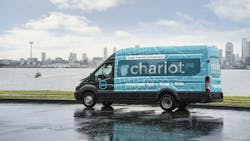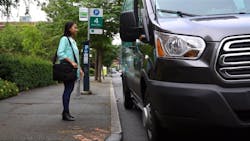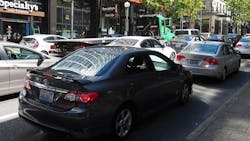Somewhere between traditional and Uber, new takes on urban transport
Uber-style ride-sharing has improved on the old taxi experience even as cities across the country are feverishly brainstorming ideas for public transit and alternative transportation. Some are betting it's still not enough, and that plenty more will have to happen to meet 21st century people-moving needs.
The primary challenge is urban density. It's a geographic and economic reality that people have drifted toward urban and metro areas, where commerce, jobs and life options abound. But only so many cars transporting humans — and trucks supplying their every need — can squeeze into the confines of those areas and their roads.
Necessity being the mother of invention, the situation has transformed cities into hotbeds for transit and supply chain innovation. And there could be a sweet spot for other improvements similar to what happened with ride-sharing, which tracks app users' locations and lets them input where they'd like to go, watch their pick-up car arrive promptly on a live map and pay easily — often much less than a cab or livery service.
It's a distinctly more convenient, transparent option than it was to hail or call for a cab and helplessly watch a meter click up or else pay premium "executive car" rates. So why not apply the same concepts elsewhere such as shuttle-type services, where processes and customer service might be clunky, carryover and not quite up to 2017 possibilities?
Ford Motor Co. is an example of a company doing just that, now that it's acquired and is expanding its Chariot shuttle van business in U.S. cities, trying on a notably different hat than its trusty vehicle manufacturer one. Chariot was conceived as a supplement to crowded or limited public transit options.
Seattle is the latest city to see Ford Transit passenger vans running Chariot routes. The service there is first targeting businesses that need to get groups around to work, hotels, conferences and so on. Just as group van services like Super Shuttle offer a cheaper ride but typically take somewhat longer due to multiple pick-ups and drop-offs, Courier can offer a lower-cost fare vs. a solo ride though perhaps a longer wait and route time.
Ideas, anyone?
That's the kind of thinking that's needed — and might be applied in many ways around the country — according to the OEM.
"The conversation is important, and it's important in cities like Seattle that are growing at quite an exponential rate," said John Kwant, vice president of city solutions for Ford Smart Mobility LLC, at a transportation roundtable discussion in late June. "We think cities like Seattle are facing what I would call a mobility paradox, and that is if you believe the trends and what demographers would say, 60-70% of the world's population is going to live in cities by mid-century.
"It's not going to happen if it's in today's transportation paradigm," he continued. "We really have to think about how we're going to move people around."
Kwant put a finer point on it, noting that roadways are at their limits and one-person-per-vehicle won't work. "We've opened the highways, we've filled them, and now we have to figure out a way to change that carrying capacity picture," he said.
Ali Vahabzaden, co-founder and CEO of Chariot, said he launched the service after having lived in cities like New York, London and San Francisco and never owned a car — just "trying to figure out how to get around in the city and commute more effectively."
"I was inspired by these ad-hoc, informal transportation networks that you find from Brooklyn to Moscow to Tel Aviv, these vans running up and down major thoroughfares. They call them 'dollar vans' or 'cheroots' or a whole host of different names," Vahabzaden recalled. "All I did in San Francisco in 2014 was formalize it into a safer, more reliable form of transport we call Chariot."
Chariot originally used a crowd-sourced model where individuals would download the app, enter their home and work locations, and a route would be added once enough people had signed on to use it.
Like the enterprise-focused launch in Seattle aims to, though, Chariot attracted businesses and organizations including the University of San Francisco, the San Francisco YMCA and Wholefoods in Austin, TX, that wanted to move employee or client groups around, Vahabzaden said.
Mark Hallenbeck, director of the Washington State Transportation Center, noted that urban transportation needs are spurring discussion and collaboration — and the creation of new business models — between municipalities and private-sector companies. "There are changes in ... how you can both serve the public good and yet make a business out of it, because those things kind of have to happen," he said.
Speaking of next-gen transportation efforts in Seattle, a city known for varied and forward-thinking public transit, he noted that "the city has an awful lot of pressure, and there's an awful lot happening as a result of it."
Further considerations
As new services and public-private collaborations spring up to help fill the gaps in transit needs, there are sticking points and underlying issues that could make or break them. Several came up in the panelists' discussion.
Equity in transportation. When it comes to new mobility endeavors, basing everything on technology doesn't work for everyone. The smartphone today has become the key component enabling access to apps to call you a ride, access a train or bus schedule, and often navigate drivers and pedestrians where they're going.
But that can be prohibitive, especially for certain demographics like economically disadvantaged communities and senior citizens, who account for a fast-growing portion of the population. Many people may not want or may not be able to use technology to get around and manage various aspects of their lives.
On a related note, not everyone speaks the same language. As transit and transportation systems evolve, it's more than a side note to consider functionality regardless of language or literacy.
Cash is king. It's a well-worn phrase, but offering new ways for people to get around in urban areas can't only be a public or private expense — or at least not entirely, as Hallenbeck mentioned. New services and innovations tend to spring up because there's an opportunity to make money.
Think about a citywide bike-sharing service that requires a sizeable initial investment but is poorly received and poorly managed, ultimately having little or no effect in reducing vehicle traffic. It's got to be used and useful if it's going to be worth it.
Piggybacking on that point is ease of payment. How will people pay for these new transportation modes and innovations to come? One suggestion in this regard that panelists said could help bridge potential technology and language barriers was to use an chipped card payment system like Seattle's ORCA cards for bus, train and ferry rides.
Changing minds. Largely, the issue of transporting people has to do with getting them to and from jobs that they work, and secondarily relates to leisure, shopping and other travel. So it's not just considering how to get more out of limited roadways but also how to take vehicles off the road, and sometimes changing people's attitudes about vehicle use.
Business policies, for instance, could support that long-supposed concept that remains elusive in 2017: more location flexibility for workers, where possible. Or you can flip the transportation equation around — bring business to the consumer — with things like multi-stop delivery van services such as those launched in the last decade or so at grocery stores and pharmacies.
In many cases, that sort of exchange isn't particularly good now and still raises a number of privacy and security issues, as data connectivity often does.
Panelists stressed that sharing aggregated, personally de-identified transaction data between the various parties involved could help, if that can be done reliably. An example raised was the city of Seattle partnering with Lyft to shuttle people to train stations. "I think there's a level of [data] sharing that we have to get to, both public and private, so that we can help manage the system better," Kwant said.
The destination — and "dissonance." Where is this all going? The goal is that individuals and groups can easily, quickly and affordably get themselves around in challengingly dense urban areas, and it doesn't require them to drive themselves.
Wait, a system where people don't have to drive themselves and can get around? You guessed it: autonomous vehicles are seen as a part — maybe a big one — of allowing that to happen. That's the underlying destination, panelists pointed out, to which new transportation modes and their enabling data and technology systems apparently are headed.
"As the car or the bus or the shuttle become just another 'node' in the Internet of Things, how do we begin to orchestrate all those things over time?" Kwant asked. "With the flexibility you're trying to preserve in the [public] budget, how do we manage those assets so that they begin to sing together in harmony in some of the dissonance that we see now?"
"We think what you're ultimately building for and constructing," he contended, "is that infrastructure and that system that supports an autonomous future."
Therein could be another "mobility paradox," as Kwant had put it. The need for mobility solutions and technology to support them is focused on choked-off cities, but the self-driving cars and trucks that are becoming a bygone conclusion work best so far in less-congested, more rural areas where traffic patterns are simpler.
It's just one discussion of city mobility and one supplemental service fleet providing alternate means of transportation. Urban roadway logjams are far from fixed, and many questions in the ongoing future mobility discussion — including which alternate transport services will catch on and work, and which won't — still need answers.
About the Author
Aaron Marsh
Aaron Marsh is a former senior editor of FleetOwner, who wrote for the publication from 2015 to 2019.



